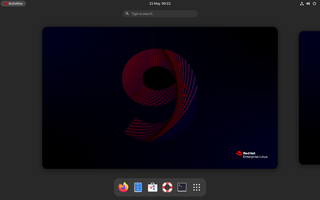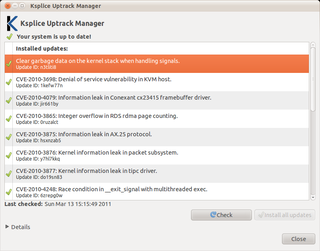Related Research Articles

A Linux distribution is an operating system made from a software collection that includes the Linux kernel, and often a package management system. Linux users usually obtain their operating system by downloading one of the Linux distributions, which are available for a wide variety of systems ranging from embedded devices and personal computers to powerful supercomputers.

Red Hat, Inc. is an American software company that provides open source software products to enterprises and is a subsidiary of IBM. Founded in 1993, Red Hat has its corporate headquarters in Raleigh, North Carolina, with other offices worldwide.

Red Hat Enterprise Linux (RHEL) is a commercial open-source Linux distribution developed by Red Hat for the commercial market. Red Hat Enterprise Linux is released in server versions for x86-64, Power ISA, ARM64, and IBM Z and a desktop version for x86-64. Fedora Linux and CentOS Stream serves as its upstream source. All of Red Hat's official support and training, together with the Red Hat Certification Program, focuses on the Red Hat Enterprise Linux platform.
A hypervisor is a type of computer software, firmware or hardware that creates and runs virtual machines. A computer on which a hypervisor runs one or more virtual machines is called a host machine, and each virtual machine is called a guest machine. The hypervisor presents the guest operating systems with a virtual operating platform and manages the execution of the guest operating systems. Unlike an emulator, the guest executes most instructions on the native hardware. Multiple instances of a variety of operating systems may share the virtualized hardware resources: for example, Linux, Windows, and macOS instances can all run on a single physical x86 machine. This contrasts with operating-system–level virtualization, where all instances must share a single kernel, though the guest operating systems can differ in user space, such as different Linux distributions with the same kernel.
In computing, paravirtualization or para-virtualization is a virtualization technique that presents a software interface to the virtual machines which is similar, yet not identical, to the underlying hardware–software interface.

QEMU is a free and open-source emulator. It emulates the machine's processor through dynamic binary translation and provides a set of different hardware and device models for the machine, enabling it to run a variety of guest operating systems. It can interoperate with Kernel-based Virtual Machine (KVM) to run virtual machines at near-native speed. QEMU can also do emulation for user-level processes, allowing applications compiled for one architecture to run on another.

virt-manager is a desktop virtual machine monitor primarily developed by Red Hat.
The following is a timeline of virtualization development. In computing, virtualization is the use of a computer to simulate another computer. Through virtualization, a host simulates a guest by exposing virtual hardware devices, which may be done through software or by allowing access to a physical device connected to the machine.

Kernel-based Virtual Machine (KVM) is a free and open-source virtualization module in the Linux kernel that allows the kernel to function as a hypervisor. It was merged into the mainline Linux kernel in version 2.6.20, which was released on February 5, 2007. KVM requires a processor with hardware virtualization extensions, such as Intel VT or AMD-V. KVM has also been ported to other operating systems such as FreeBSD and illumos in the form of loadable kernel modules.

oVirt is a free, open-source virtualization management platform. It was founded by Red Hat as a community project on which Red Hat Virtualization is based. It allows centralized management of virtual machines, compute, storage and networking resources, from an easy-to-use web-based front-end with platform independent access. KVM on x86-64, PowerPC64 and s390x architecture are the only hypervisors supported, but there is an ongoing effort to support ARM architecture in a future releases.

Ksplice is an open-source extension of the Linux kernel that allows security patches to be applied to a running kernel without the need for reboots, avoiding downtimes and improving availability. Ksplice supports only the patches that do not make significant semantic changes to kernel's data structures.

libvirt is an open-source API, daemon and management tool for managing platform virtualization. It can be used to manage KVM, Xen, VMware ESXi, QEMU and other virtualization technologies. These APIs are widely used in the orchestration layer of hypervisors in the development of a cloud-based solution.
In computing, SPICE is a remote-display system built for virtual environments which allows users to view a computing "desktop" environment – not only on its computer-server machine, but also from anywhere on the Internet – using a wide variety of machine architectures.

Red Hat Virtualization (RHV) formerly known as Red Hat Enterprise Virtualization, is an x86 virtualization product developed by Red Hat, and is based on the KVM hypervisor. Red Hat Virtualization uses the SPICE protocol and VDSM with a RHEL-based centralized management server. The platform can access user and group information from either an Active Directory or FreeIPA domain which enables it to allocate resources effectively based on permissions. Built for use in enterprise datacenters RHV can support up to 400 hosts in a single cluster and no upper limit on the total number of hosts it can support. Development of RHV has ceased and as of August 2020 the product is now only receiving maintenance updates, with extended life phase updates provided until 2026. The successor to RHV is Red Hat's OpenShift container platform.
In computing, kernel same-page merging (KSM), also known as kernel shared memory, memory merging, memory deduplication, and page deduplication is a kernel feature that makes it possible for a hypervisor system to share memory pages that have identical contents between multiple processes or virtualized guests. While not directly linked, Kernel-based Virtual Machine (KVM) can use KSM to merge memory pages occupied by virtual machines.
Second Level Address Translation (SLAT), also known as nested paging, is a hardware-assisted virtualization technology which makes it possible to avoid the overhead associated with software-managed shadow page tables.

The Open Virtualization Alliance (OVA) was a Linux Foundation Collaborative Project committed to foster the adoption of free and open-source software virtualization solutions including KVM, but also software to manage such, e.g. oVirt. The consortium promoted examples of customer successes, encouraged interoperability and accelerated the expansion of the ecosystem of third party solutions around KVM.
Docker is a set of platform as a service (PaaS) products that use OS-level virtualization to deliver software in packages called containers. The service has both free and premium tiers. The software that hosts the containers is called Docker Engine. It was first started in 2013 and is developed by Docker, Inc.
Virtuozzo is a software company that develops virtualization and cloud management software for cloud computing providers, managed services providers and internet hosting service providers. The company’s software enables service providers to offer Infrastructure as a service, Container-as-a-Service, Platform as a service, Kubernetes-as-a-Service, WordPress-as-a-Service and other solutions.
Giora Yaron is a Doctor of Physics, businessman, and chairman of the board of directors of the Tel Aviv University.
References
- 1 2 3 Lan, Shlomit (28 May 2017). "Dr. Giora Yaron: Startups need carrots not sticks". Globes.
- ↑ Savitz, Eric (4 September 2008). "Red Hat Buys Virtualization Company". Barron's.
- ↑ Wrobel, Sharon (5 September 2008). "Red Hat Buys Qumranet". Jerusalem Post.
- ↑ Businessweek.com Archived March 13, 2008, at the Wayback Machine , "Sequoia, Norwest, Storm Fund Israeli Startups"
- ↑ Heise.de Archived March 11, 2008, at the Wayback Machine , "Virtualization solution KVM will be in the next version of Linux"
- ↑ ITbusinessedge.com Archived 2009-01-07 at the Wayback Machine , "Barbarians at the VMware Gate"
- ↑ "Skating on Solid ICE Desktop Virtualization"
- ↑ Interview: Avi Kivity Archived 2007-04-26 at the Wayback Machine on KernelTrap
- ↑ Zadok, Shahar (26 May 2008). "Six Israeli start-ups among Gartner "Cool Vendors": The Cool Vendors 2008 report covers 172 companies". McClatchy.
- ↑ "Red Hat Advances Virtualization Leadership with Qumranet, Inc. Acquisition" (Red Hat press release)
- ↑ "Red Hat buys Qumranet for $107M. What does this mean for KVM and SolidICE?". BrianMadden.com. Retrieved 2018-06-26.
- ↑ Denne, Scott (5 February 2013). "Qumranet Founders Emerge With $26M for Latest Cloud Venture, Ravello". Wall Street Journal . Retrieved 5 February 2020.
- ↑ Vance, Ashlee (4 September 2008). "Red Hat Buys a Seat at the Virtualization Table". New York Times. Retrieved 5 February 2020.
- ↑ Grimland, Guy (5 September 2008). "Qumranet Makes Exit With $115m Sale". Haaretz. Retrieved 5 February 2020.
- ↑ Cohen, Sagi (29 May 2019). "Israeli Serial Entrepreneurs Found Fourth Startup". Haaretz. Retrieved 8 February 2020.
- ↑ Businessweek.com "Qumranet, Inc."